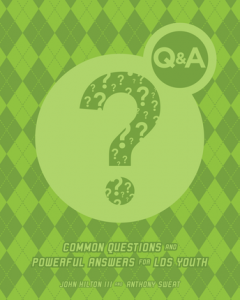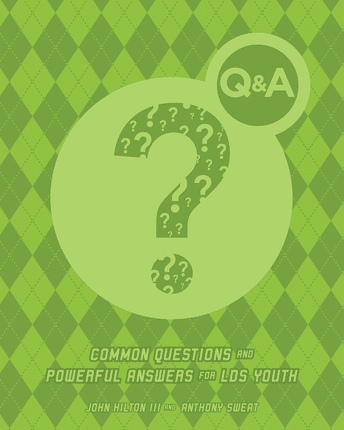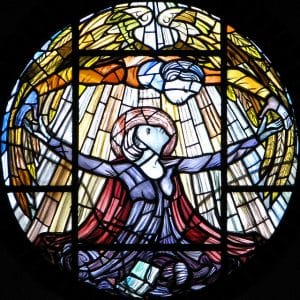
John Hilton III and Anthony Sweat are two elders who have worked with youth throughout their Church career, also both work as assistant professor at Brigham Young University. After their formation, they wrote three books to answer the questions which usually are asked by teenagers, such as “Why?”, “How?” and “The Big Picture”. The book which I’m going to review, Common Questions and Powerful Answers for LDS Youth, is a recompilation from this three previous books.
This is a simple book with nice typographies and cool pictures, with amusing and funny writing, which answers common questions that each Mormon teenager can ask themselves sometimes. The title of each chapter is categorized in colors: in orange are illuminated the chapters which answers to ‘how’; in blue, those that answer to ‘why’, and in green those questions which can’t be categorized in the other two categories.
Each chapter has a similar structure. At the beginning it mentions a speech from either an authority or a biblical verse and from this the entire chapter develops. In addition, the book has boxes to implement the lessons being taught, including study it from the scriptures or easy games as analogies. These can be find in each chapter, by example Tell Me One More Time, which is showed at the end of the chapter and summarizes in a few points what was teach by the lesson; another one is Do Try This At Home!, which gives easy activities that anyone can do at home to clarify the ideas and concepts of the chapter; each chapter also includes other questions related to the original question posed in the title of the chapter.
The authors know that teenagers are surround with science in schools, because of this, the writing has scientific references included as well as theories, experiments, methods and investigations. In this frame, it is a simple book which can easily be used as reference. BUT. It has a big problem: it is geared to young men.
That’s right, when I was reading I realized this affirmation; first, for the almost nonexistent reference to sisters talks’ in it. As I previously mentioned, each chapter answers a question constructed from a published church talk or a biblical verse. It is incredible that none of the chapters take a sister’s speech as its base premise to be explored. It is shocking to me that the compilation of these books, the authors seemed unable to find any useful talk from a president or secretary of Young Women. It’s astonishing that in the 258 pages that this book has just is quoted 4 sisters — one of them in a speech coordinated with her husband. It more commonly quotes women scientists or journalists, leaving out Mormon women.
The only chapter where young women are visible is in Why Should I Dress Modestly? However, the young women in this case are there just to blame! Women’s clothing is used support conceptual pornography and unmoral temptation. This is repeated in following chapters, but the idea goes beyond justifying misogyny, because it gives a tip that staying sexually pure equals dressing modestly. The argument is that when we don’t do it we send a message to others that our body isn’t important to us. How different is this than to say a woman is raped because she asked for it by her clothing?
In the same way, this chapter shows a characterist that always have hated from mormons, elitism, which can be particulary problematic in teenagers:
If young people are constantly revealing their skin, who will they attract? They will attract “piranha” boys and girls who are primarily interested in their flesh. On the other hand, if a young person cast out righteousness, intelligence, spiritually, humor, and confidence, that is exactly who he or she will attract: young men and women who appreciate righteousness, intelligence, spiritually, humor, and confidence.
This way of think restrict the relationships of Mormon youth, because it make them feel superior than teenagers from other religions, or those without religion. In truth, boys and girls who appreciate righteousness, intelligence, spiritually, and confidence can be found anywhere, and dress in any way.
In contrast, a chapter that definitely deleted girls from his target is Why Should I Serve a Mission? Certainly the authors knew that limiting the writing to young men was problematic, so they resolved it with this explanation:
Although this chapter is primarily geared toward young men, many of the principles discussed also apply to young women who desire to serve full-time missions.
So why no geared the chapter to girls too?! In addition to the three lines above, there is just one tiny box directed to young women titled What About Young Women And Missions? 30 % of missionary is from young women, implying that sister missionaries are unusual. A entire chapter dedicated to young men of the age to be involved in missionary work, his duties as a Priesthood Holder, the skills that males will get, and that kind of stuff. Most sad chapter of the book.
This chapter, like thousands of talks, conferences, classes, announcements and church duties, minimize, relegate, underestimate young women, but, worst of all, it forget them. How can a girl identify with a book that doesn’t quote any woman? It is the same as how women are identified in a General Conference; when only three or four colorful dresses are showed between lots of black suits?
I only recommend this book as one more of the library of Seminary, Young Women and Young Men in any ward, as reference for lessons.
John Hilton III y Anthony Sweat son dos élderes que han trabajado con jóvenes a través de su carrera en la Iglesia, además ambos trabajan como asistentes de profesores en la Universidad de Brigham Young. A partir de su formación, ellos escribieron tres libros para responder a las preguntas con las que usualmente eran más cuestionados, estos son “Why?”, “How?” y “The Big Picture”. El libro que a continuación reseñaré, “Common  Questions and Powerful Answers for LDS Youth”, es una recopilación de los anteriores.
Questions and Powerful Answers for LDS Youth”, es una recopilación de los anteriores.
Se trata de un sencillo libro con atractivas tipografías y llamativas imágenes que con una redacción amena y divertida responde a las típicas preguntas que cada adolescente mormón puede realizarse en algún momento de su vida. El título de cada capítulo está categorizado por colores: en naranja se iluminan los capítulos que responden a ‘cómo’; en azul, aquellos que responden a ‘por qué, y en verdes están otras preguntas que no entran en las otras dos categorías. Cada capítulo tiene un formato similar, se inicia con un discurso de una autoridad o algún versículo y a partir del mismo se desarrolla todo el capítulo. De igual manera, a lo largo del libro se encuentra recuadros para aplicar lo enseñado, estudiarlo en las escrituras o relacionarlo con sencillos juegos que sirven como analogías. Algunos de ellos son recurrentes en cada capítulo, por ejemplo Tell Me One More Time, el cual aparece al final del capítulo y sintetiza en simples puntos lo que se enseñó durante la lección; otro es Do Try This At Home!, el cual da fáciles actividades que cualquiera puede hacer en su casa para dejar más en claro algunas ideas u conceptos; también cada capítulo incluye otras preguntas relacionadas con la pregunta que nombra el capítulo. Los autores saben que los adolescentes están rodeados de ciencia en las escuelas, por ello la redacción también incluye múltiples referencias científicas, como teorías, métodos, experimentos, datos e investigaciones. En síntesis se trata de un sencillo libro que puede ser una útil referencia, sin embargo, tiene un gran problema, está dirigido sólo a hombres jóvenes.
En efecto, mientras iba recorriendo las páginas me di cuenta de mi afirmación anterior, primero, por la nula referencia de discursos de hermanas entre sus páginas. Como ya lo mencioné antes, cada capítulo se desarrolla a partir de un discurso o un versículo, increíble es que ninguno de estos capítulo se base en el discurso de alguna hermana autoridad en la Iglesia. Es sorprendente que a lo largo de la investigación de estos tres libros –recordemos que el reseñado es sólo una recopilación de los anteriores tres– Andrew y John no hayan encontrado ni un solo artículo de alguna hermana presidenta o secretaria de las Mujeres Jóvenes relevante de citar. Tan extraordinario es que a través de este libro de 258 páginas sólo se cite a 4 hermanas y una de ellas sea en un discurso coordinado con su esposo. Se recurre a más científicas o periodistas como referencia, que a hermanas.
El único capítulo en el que están evidentemente presente las adolescentes fue en el 17, Why Should I Dress Modestly? Sin embargo, se hacen presentes sólo para culpabilizarlas de perpetuar la cultura pornográfica, además de convertirse en una tentación inmoral. Unos capítulos más adelante también se menciona este tema, pero va más allá con una redacción justificadora de la misioginia, pues señala como consejo para mantenerse sexualmente puro el vestirse modestamente, pues, cuando no lo hacemos mandamos a otros el mensaje de que nuestro cuerpo no es importante para nosotros; ¿Qué tan diferentes son estas líneas de señalar que una mujer es violada porque se lo buscó? De igual manera este capítulo expone una característica que siempre me ha parecido detestable de la comunidad mormona , el elitismo, el cual puede ser particularmente problemático entre los jóvenes, dado que advierte que si nos vestimos de determinada manera atraeremos a personas negativas.
If young people are constantly revealing their skin, who will they attract? They will attract “piranha” boys and girls who are primarily interested in their flesh. On the other hand, if a young person cast out righteousness, intelligence, spiritually, humor, and confidence, that is exactly who he or she will attract: young men and women who appreciate righteousness, intelligence, spiritually, humor, and confidence.
Este tipo de pensamientos limitan mucho las relaciones de los jóvenes mormones, pues los hacen sentir mejores que los jóvenes de otras religiones o si religión, cuando en realidad chicas y chicos que aprecien la inteligencia, la espiritualidad y la confianza se pueden encontrar en cualquier parte y vestidos de cualquier manera.
En cambio, un capítulo que definitivamente elimina a las chicas de sus pretenciones es Why Should I Serve a Mission? Seguramente John y Andrew en la reedición recibieron algún prudente comentario advirtiéndoles que este capítulo sólo estaba dirigido a jóvenes varones, lo cual ellos resolvieron con las siguientes líneas:
Although this chapter is primarily geared toward young men, many of the principles discussed also apply to young women who desire to serve full-time missions.
Correcto, John y Andrew, entonces ¡¿por qué no dirigieron el capítulo a las chicas también?! Además de las tres líneas de arriba sólo hay un recuadro más titulado What About Young Women And Missions?, como si un 30 % del total de la obra misional no fuese hecho por mujeres, como si fuera algo completamente inusual que una chica sirva en una misión. Un capítulo entero dedicado a los élderes que están a punto de servir en una misión, a sus novias, a sus deberes como poseedores del sacerdocio, a las capacidades varoniles que adquirirán, a historias de élderes y presidentes que han servido en misiones y ese tipo de material. El capítulo más triste de todo el libro.
Este libro, al igual que miles de discurso, conferencias, clases, anuncios y tareas de la Iglesia, minimiza, relega, menosprecia a las mujeres jóvenes, pero, lo peor de todo, las olvida, como eternamente se ha sentido olvidada una mujer en la Iglesia mormona. ¿Cómo una chica podrá sentirse identificada con un libro que no cita a otra mujeres, al igual que cómo podrá sentirse identificada en una Conferencia General cuando sólo destacan tres o cuatro coloridos vestidos entre decenas de trajes negros?
Sólo recomiendo este libro como uno más de la biblioteca de cualquier barrio para las lecciones de Seminario, Mujeres Jóvenes y Hombres Jóvenes.







7 Responses
That’s really too bad the girls are almost entirely left out. Sounds like the chapter on modesty is terrible. Sigh.
It is terrible!
Thanks for your review. This is very disappointing, but not terribly surprising. YW are so often an afterthought in the Church.
Thanks for comment it.
Wow, this review sounds a lot like the previous one: https://exponentii.org/book-review-were-with-you-counsel-and-encouragement-from-your-brethren/
I guess it only makes sense that our androcentric culture is reflected in our books.
I have three sons, but I’ve worked hard to include women’s voices in their reading and education, including on church topics. I’ve also served as a YW leaders multiple times and it’s been frustrating and disappointing for years how much extra work there is to be done to include women’s voices in youth lessons.
How disappointing and frustrating. How many decades will we have to wait for the church to notice that girls are “youth” too, I wonder?